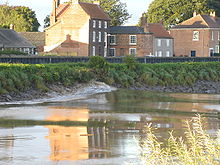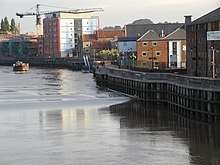Tidal bore

A tidal bore (or simply bore in context, or also aegir, eagre, or eygre) is a tidal phenomenon in which the leading edge of the incoming tide forms a wave (or waves) of water that travel up a river or narrow bay against the direction of the river or bay's current. As such, it is a true tidal wave and not to be confused with a tsunami, which is a large ocean wave traveling primarily on the open ocean.
The phenomenon
Bores occur in relatively few locations worldwide, usually in areas with a large tidal range (typically more than 6 metres (20 ft) between high and low water), and where incoming tides are funneled into a shallow, narrowing river or lake via a broad bay. The funnel-like shape not only increases the tidal range, but it can also decrease the duration of the flood tide, down to a point where the flood appears as a sudden increase in the water level. Note the tidal bore takes place during the flood tide and never during the ebb tide.
A tidal bore may take on various forms, ranging from a single breaking wavefront with a roller — somewhat like a hydraulic jump[1] — to ‘undular bores’, comprising a smooth wavefront followed by a train of secondary waves (whelps).[2] Large bores can be particularly dangerous for shipping, but also present opportunities for river surfing.[2]
Two key features of a tidal bore are the intense turbulence and turbulent mixing generated during the bore propagation, as well as its rumbling noise. The visual observations of tidal bores highlight the turbulent nature of the surging waters. The tidal bore induces a strong turbulent mixing in the estuarine zone, and the effects may be felt along considerable distances. The velocity observations indicate a rapid deceleration of the flow associated with the passage of the bore as well as large velocity fluctuations.[3][4] A tidal bore creates a powerful roar that combines the sounds caused by the turbulence in the bore front and whelps, entrained air bubbles in the bore roller, sediment erosion beneath the bore front and of the banks, scouring of shoals and bars, and impacts on obstacles. The bore rumble is heard far away because its low frequencies can travel over long distances. During his expedition in the Qiantang River mouth, Captain Moore heard the first murmur of the tidal bore one hour before it reached his Pandora ship. The low-frequency sound is a characteristic feature of the advancing roller in which the air bubbles entrapped in the large-scale eddies are acoustically active and play the dominant role in the rumble sound generation.[5]
The word bore derives through Old English from the Old Norse word bára, meaning a wave or swell.
Rivers with tidal bores
Rivers that have been known to exhibit bores include those listed below.[6]
Asia
- Ganges–Brahmaputra, India, Bangladesh
- Indus River, India, Pakistan
- Qiantang River, China, Tidal bore of Qiantang River which has the world's largest bore, up to 9 metres (30 ft) high, traveling at up to 40 kilometres (25 mi) per hour.
- Batang Lupar or Lupar River, near Sri Aman, Malaysia. The tidal bore is locally known as benak [2].
Australia
Europe
United Kingdom


- River Dee, Wales / England
- River Mersey
- The Severn bore on the River Severn, Wales / England up to 2 metres (6.6 ft) high
- The Trent Aegir on the River Trent, up to 1.5 metres (4.9 ft) high, England. Also other tributaries of the Humber Estuary
- River Parrett
- River Welland
- River Kent
- River Great Ouse
- River Ouse, Yorkshire, like the Trent bore, this is also known as "the Aegir".
- River Eden
- River Esk
- River Nith
- River Lune, Lancashire
- River Ribble, Lancashire

France
The phenomenon is generally named un mascaret in French[7] but some other local names are preferred.[6]
- Seine, locally named la barre, had a significant bore until the 1960s. Since then it has been practically eliminated by dredging and river training [6].
- Baie du Mont Saint Michel including Couesnon, Sélune, Sée.[6]
- Arguenon [6]
- Baie de la Frênaye [6]
- Vire [6]
- Sienne [6]
- Vilaine, locally named le mascarin
- Dordogne [6]
- Garonne [6]
North America

- The Turnagain arm of Cook Inlet, Alaska. Up to 2 metres (6.6 ft) and 20 km/h.
Most rivers draining into the upper Bay of Fundy between Nova Scotia and New Brunswick have tidal bores. Notable ones include:
- The Petitcodiac River. Formerly the highest bore in North America at over 2 metres (6.6 ft); however, causeway construction and extensive silting reduced it to little more than a ripple, until the causeway gates were opened on April 14, 2010 as part of the Petitcodiac River Restoration project and the tidal bore began to grow again[8].
- The Shubenacadie River, also off the Bay of Fundy in Nova Scotia. When the tidal bore approaches, completely drained riverbeds are filled. It has claimed the lives of several tourists who were in the riverbeds when the bore came in.[citation needed] Tour boat operators offer rafting excursions in summer.
- The bore is fastest and highest on some of the smaller rivers that connect to the Bay including the River Hebert and Maccan River on Cumberland Basin, the St. Croix, Herbert and Kennetcook Rivers in the Minas Basin, and the Salmon River in Truro.
South America
- Amazon River in Brazil and Orinoco River in Venezuela, up to 4 metres (13 ft) high, running at up to 13 miles per hour (21 km/h). It is known locally as the pororoca.[9]
- Mearim River in Brazil.
- Araguari River in Brazil.
Lakes with tidal bores
Lakes with an ocean inlet can also exhibit tidal bores.[citation needed]
North America
- Nitinat Lake on Vancouver Island has a sometimes dangerous tidal bore at Nitinat Narrows where the lake meets the Pacific Ocean. The lake is popular with windsurfers due to its consistent winds.
See also
- 1812 New Madrid earthquake, a historic earthquake in the United States that caused the Mississippi River to flow backwards temporarily
- Hydraulic jump
- Tidal race
- Tonlé Sap, a lake and river system in Cambodia where monsoon flooding can cause the river to flow backwards temporarily
- Undular bore wave
References
- ^ Chanson, H. (2009). Current Knowledge In Hydraulic Jumps And Related Phenomena. A Survey of Experimental Results. European Journal of Mechanics B/Fluids, Vol. 28, No. 2, pp. 191-210 (DOI: 10.1016/j.euromechflu.2008.06.004 ) (ISSN 0997-7546).
{{cite book}}: External link in|title= - ^ a b c Chanson, H. (2009). Environmental, Ecological and Cultural Impacts of Tidal Bores, Benaks, Bonos and Burros. Proc. International Workshop on Environmental Hydraulics IWEH09, Theoretical, Experimental and Computational Solutions, Valencia, Spain, 29-30 Oct., Editor P.A. Lopez-Jimenez et al., Invited keynote lecture, 20 pages (CD-ROM).
{{cite book}}: External link in|title= - ^ Koch, C. and Chanson, H. (2008). Turbulent Mixing beneath an Undular Bore Front. Journal of Coastal Research, Vol. 24, No. 4, pp. 999-1007 (DOI: 10.2112/06-0688.1).
{{cite book}}: External link in|title= - ^ Koch, C. and Chanson, H. (2009). Turbulence Measurements in Positive Surges and Bores. Journal of Hydraulic Research, IAHR, Vol. 47, No. 1, pp. 29-40 (DOI: 10.3826/jhr.2009.2954).
{{cite book}}: External link in|title= - ^ Chanson, H. (2009). The Rumble Sound Generated by a Tidal Bore Event in the Baie du Mont Saint Michel. Journal of Acoustical Society of America, Vol. 125, No. 6, pp. 3561-3568 (DOI: 10.1121/1.3124781).
{{cite book}}: External link in|title= - ^ a b c d e f g h i j Chanson, H. (2008). Photographic Observations of Tidal Bores (Mascarets) in France. Hydraulic Model Report No. CH71/08, Univ. of Queensland, Australia, 104 pages. ISBN 9781864999303.
{{cite book}}: External link in|title= - ^ Template:Fr icon definition of mascaret
- ^ Petitcodiac River changing faster than expected
- ^ Template:En icon Pororoca: surfing the Amazon indicates that "The record that we could find for surfing the longest distance on the Pororoca was set by Picuruta Salazar, a brazilian surfer who, in 2003, managed to ride the wave for 37 minutes and travel 12.5 kilometers."
External links
- Quiantang River Tidal Bore in China, USC Tsunami Research Group
- Nice set of photos from Chinese bore - Snopes.com
- Amateur video of the "Wiggenhall Wave" tidal bore
- link to Proudman Inst. page
- The Tidal Bore of the Seine River, France
- Tidal bores, Mascaret, Pororoca. Myths, Fables and Reality !!!
- Mascaret, Aegir, Pororoca, Tidal Bore. Quid ? Où? Quand? Comment? Pourquoi ? in Journal La Houille Blanche, No. 3, pp. 103–114]
- Turbulent Mixing beneath an Undular Bore Front in Journal of Coastal Research, Vol. 24, No. 4, pp. 999–1007 (DOI: 10.2112/06-0688.1)


